Introduction
Welcome to the Pixelmon Whitepaper
This section elaborates on the main pillars of our strategy, including Right-of-Game, Genesis NFT collections, Decentralized Autonomous Tribe, the economy for our ecosystem of games, and much more. This document serves as a guide for both existing and new members of the Pixelmon community to navigate our ecosystem and access available information.
We maintain a high-level view of each topic, aiming to balance complete information with clarity and simple explanations.
Finally, this is a live document. We will update and improve it with more and better information as the project evolves, based on your feedback and needs.
Building The First Truly Decentralised Gaming IP
Since Nakamoto’s 2008 paper, the growing interest in blockchain-based decentralised systems has prompted the rise of a multitude of different applications and solutions in the web3 space. We have seen decentralisation (or proposed solutions) across a wide variety of industries, but the majority of implementations with sizable mass adoption to date have been confined to the DeFi vertical. One noticeable exception is NFT technology, which has seen a large adoption spree in recent years, initially driven by digital artists and collectors who found NFTs to be a perfect means to eliminate intermediaries, safely transfer ownership of unique images (and sometimes the underlying IP) and earn royalties from secondary transactions.
More recently, new projects have minted NFT collections as promises of future utility across different verticals. Among these, we believe that gaming will quickly become the first consumer market to benefit and drive mass adoption of blockchain and NFT technologies.
The first attempts to decentralise game asset ownership through the blockchain used NFTs as pay-to-play or VIP-area gateway tickets to the game. In an attempt to justify high prices for these pay-to-play privileges, the solution they opted for was to embed earning into play itself, thus justifying NFT prices as a pay2play & play2earn relationship. The unfortunate outcomes of this strategy were multiple, including:
- Low focus on the iterative process of creating a quality gaming product and experience,
- Underlying business objectives tailored to NFT purchasers as compared to gamers; and
- Unsustainable economies, where new purchasers fed the old without a true “consumer” (gamer) stakeholder present.
Instead, our intent is to create the first Decentralised Game IP Ownership (DGIO) system that provides the right incentives to Play to Own (P2O) while leveraging the proven revenue model in Free to Play (F2P) gaming and microtransactions. At the same time this system sets the basis to expand the IP across multiple verticals beyond gaming.
The key to achieve the above lies in clearly differentiating between the interests of those parties looking to purchase artwork and commercialise the underlying IP assets from the interests of gamers looking to consume the product – not just in company strategy but in the underlying legal and contractual rights allocated among the NFT collections.
In particular, we envision a 2-tiered NFT system which is composed of Genesis NFTs deployed on Ethereum main Layer (L1) and In-Game NFTs deployed on Eth Layer 2 chains (L2). The L1 Genesis NFTs include shared IP ownership over a specific asset or asset class, while the L2 In-Game NFTs include in-game assets owned by players. At its base, (i) L1 Genesis NFTs are a product for parties interested in acquiring artwork and sourcing, negotiating, and commercialising the shared IP rights associated with that artwork (or “Asset Owners”) and (ii) In contrast, L2 In-Game NFTs are a product for consumers/gamers (or “Gamers”).
In this approach, the use of in-game assets becomes decentralized. Free-to-play (F2P) players, aiming to engage in the ecosystem on a mass adoption scale, can acquire these affordable resources through gameplay or microtransactions (both primary and secondary). Meanwhile, the potentially higher-priced Genesis ownership rights are kept distinct from the gameplay flow.
This system will be supported by a system of in-game currencies (off-chain) unique to each game, serving as the transactional medium for players and facilitating liquidity in the game's primary market. Additionally, cryptocurrencies will be accepted as a means of exchange for web3 players to trade in-game NFTs peer-to-peer within the ecosystem's marketplace.
The NFT-based fractionalized IP framework is also key to extending the gaming IP across various channels and diverse franchises. By offering fractionalized IP and royalty rights, Genesis NFT holders are motivated to source, negotiate, and commercialize that IP, thereby earning royalties in the process.
Moreover, this infrastructure addresses the longstanding challenge of content scalability in gaming by fostering a self-sustaining User Generated Content (UGC) strategy. Creators can sell L1 NFTs to cover their initial development costs, decentralize the IP they generate, and retain a productive share of their creations. This setup facilitates in-game use for Free-to-Play (F2P) players through L2 NFTs. Consequently, the IP of our games and content becomes fully decentralized, from creation to licensing. This decentralized creation model can be applied across all forms of content, including monsters, gear, map expansions, and even quests.
With User Generated Content (UGC) and Decentralized IP ownership, the game transcends its traditional boundaries to become a vibrant IP ecosystem. In this ecosystem, all three key stakeholders—Asset Owners, Creators, and Gamers—play distinct roles that mutually enhance value in a scalable way:
- Asset Owners are motivated to source, negotiate, and finalize licensing deals that enhance the Pixelmon brand IP. They are rewarded with a share of the licensing revenue, reflecting their individual contributions significantly.
- Creators drive the expansion of content, rendering the game self-sustaining and capable of growth, which in turn fosters greater retention among gamers. The IP licensing terms tied to the L1 NFTs ensure that Creators develop content that resonates with what gamers desire.
- Gamers, as the ultimate consumers of the Pixelmon game, act as the ecosystem's growth engine. Their engagement rewards all parties involved in a sustainable cycle.
As a result, the incentives for all parties are aligned, motivating each participant to engage in and contribute towards a superior IP ecosystem.
Decentralized IP System
The initial IP sublicensing agreement will involve Genesis NFT holders granting Pixelmon games the rights to use the IP associated with monsters, trainers, and gear for the creation of in-game digital assets. As previously noted, this arrangement will produce two distinct classes of NFTs, each with unique characteristics: L1 Genesis NFTs and L2 In-Game NFTs.

Genesis NFTs facilitate the decentralization and fractionalization of IP, granting owners shared rights to the underlying art's IP. Consequently, these NFTs confer a contractual right to royalties from any commercial utilization of the respective IP.
Genesis NFTs encompass both current and future collections launched on Ethereum L1, including Monsters and Trainers along with their skins, gears, and armors. While these NFTs do not offer in-game utility, holders of Genesis NFTs are anticipated to receive an in-game version of their NFT via airdrop, contingent upon the full in-game functionality of the NFT.
In-game NFTs, on the other hand, will be minted on an L2 blockchain and will encompass all primary digital assets available in the game, such as Monsters, gears, skins, and armors.
These NFTs enable fully decentralized ownership of in-game assets, allowing each player to acquire these items at no cost through gameplay, purchase them in the game's store, or trade them on the secondary marketplace with other players.
Decentralized IP Beyond Games
Holders of Genesis NFTs are granted ownership rights over a portion of the item or character's IP, along with the capacity to source, negotiate, and commercialize that IP to earn royalties. This arrangement creates a decentralized incentive system that promotes the expansion of the IP across various verticals, resulting in a positive flywheel effect that enhances the overall value of the IP and generates additional commercial opportunities.
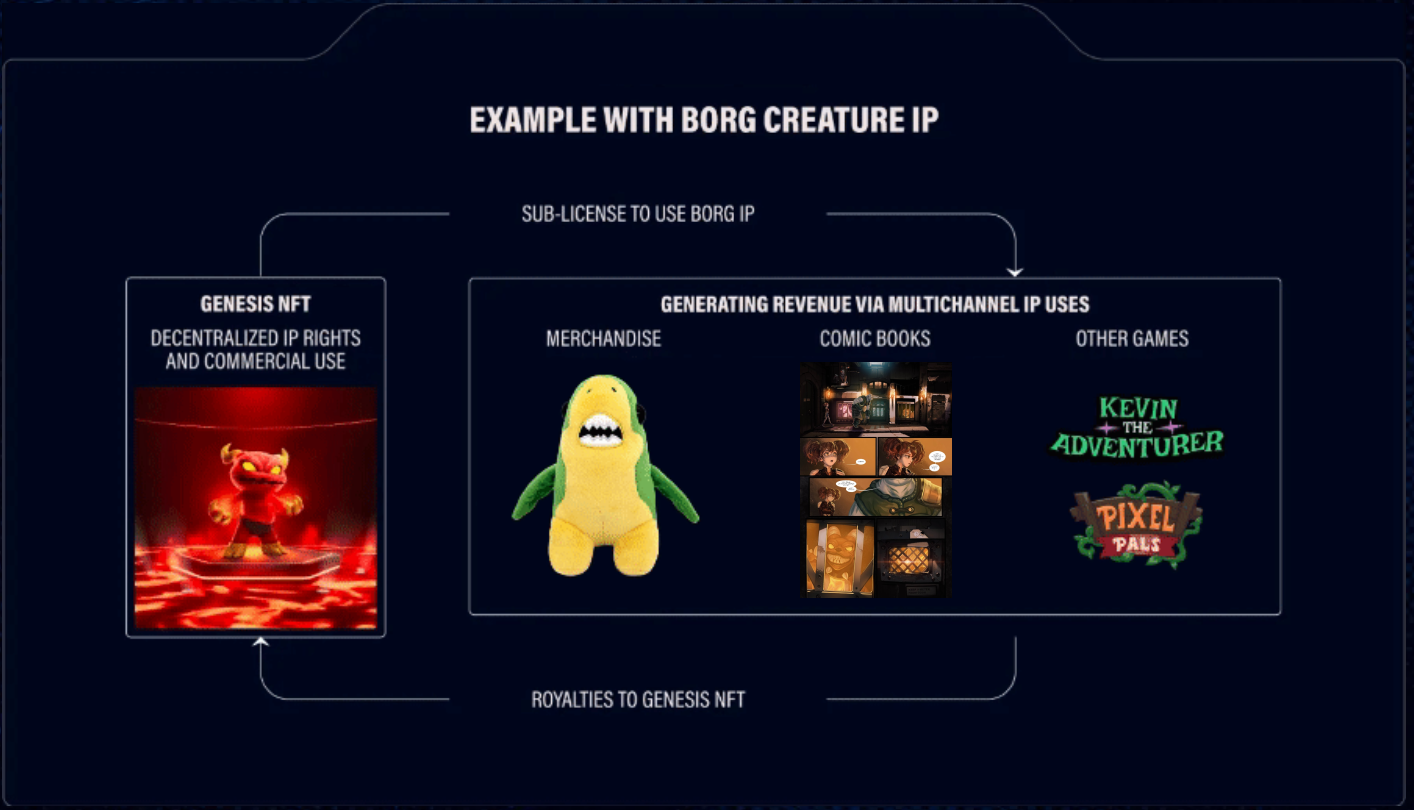
Simultaneously, Artists and Creators are encouraged to contribute their works to the project, securing funding and royalties for their contributions. More details on this can be found in the "Creator Economy" section below.
This framework offers new solutions for the game ecosystem’s success:
- Genesis NFTs establish a distributed incentive system to enhance the game ecosystem and expand the IP across various verticals.
- They also provide a scalable solution for game assets through user-generated content and create-to-earn dynamics.
- The ownership of in-game assets is poised to increase players' in-game expenditure, as dollars spent are not lost but can be recouped through sales on the secondary market. This also marks a significant step towards enabling the interoperability of assets across different games and ecosystems.
Genesis NFT Collections
E1 Creature Genesis NFTs
There are 10,005 NFTs available, each representing one of 69 distinct species, categorized into 4 origins (Water, Fire, Air, and Earth) and 6 rarity tiers. The identity of each creature is unveiled by hatching an egg.
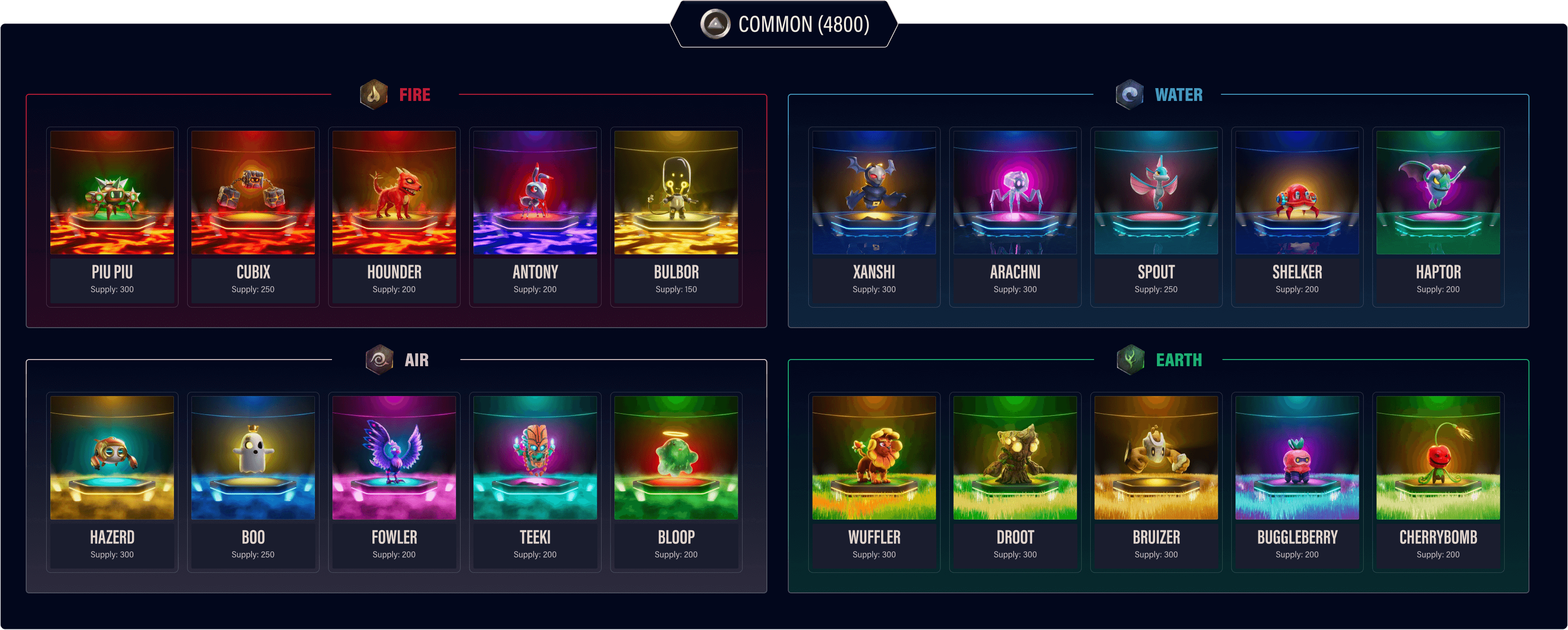 |
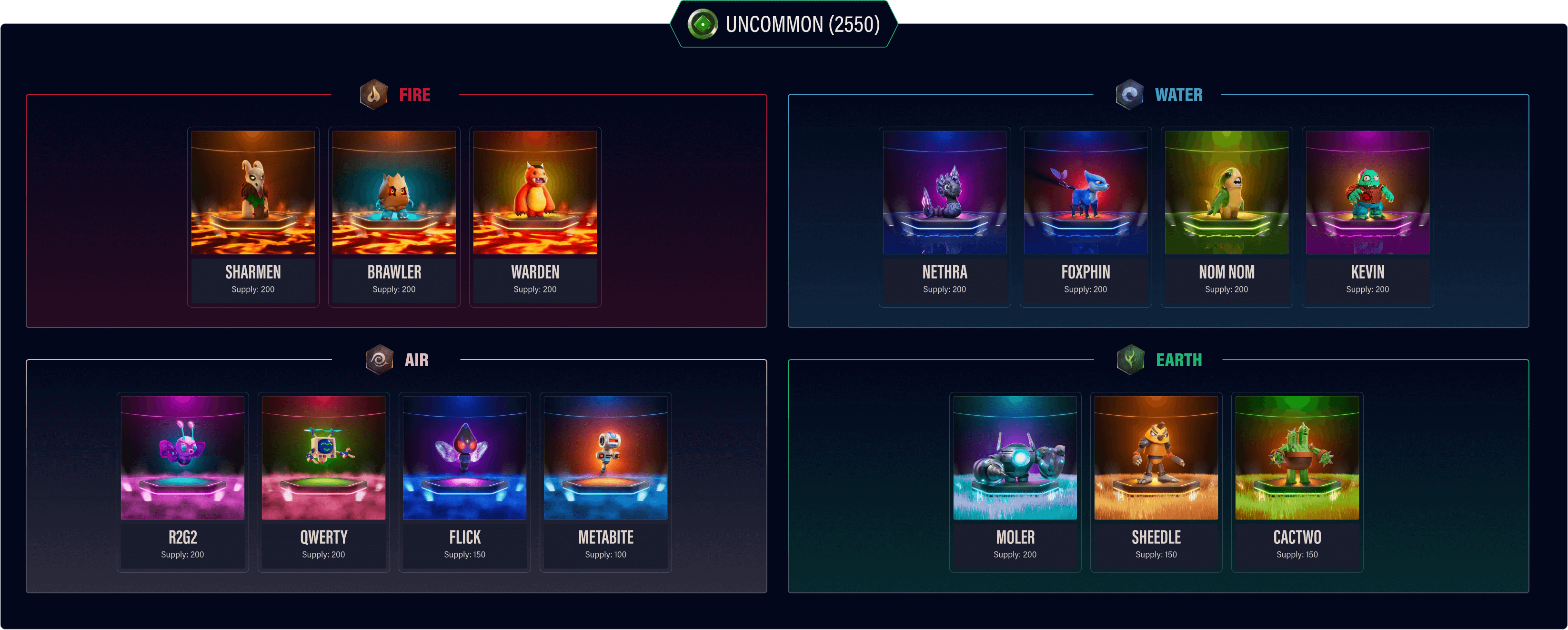 |
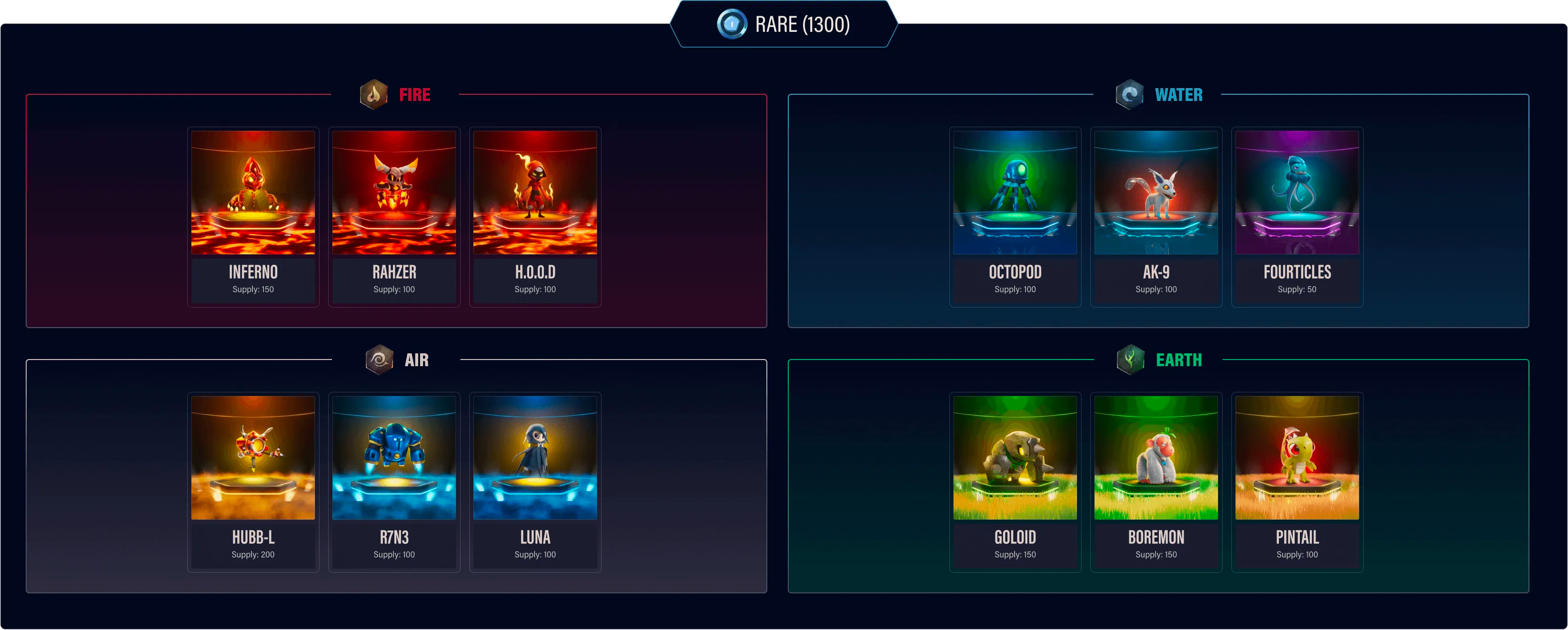 |
 |
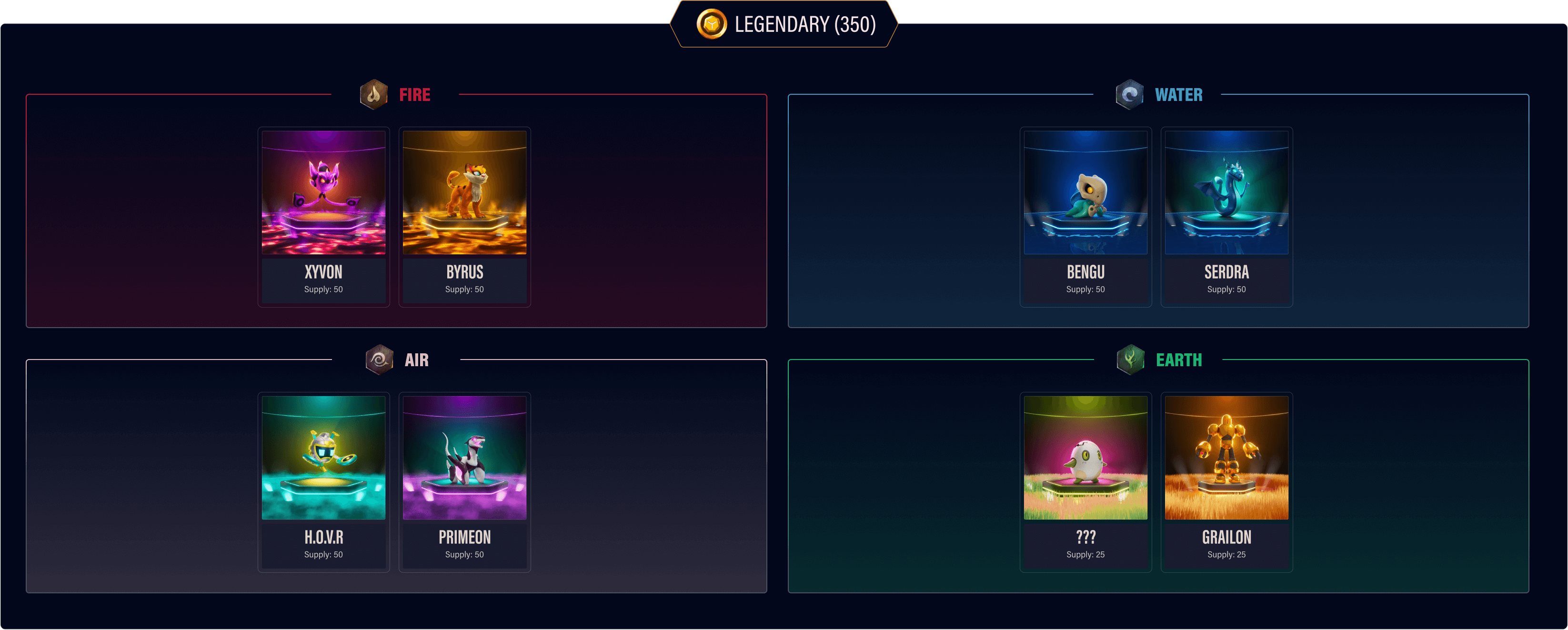 |
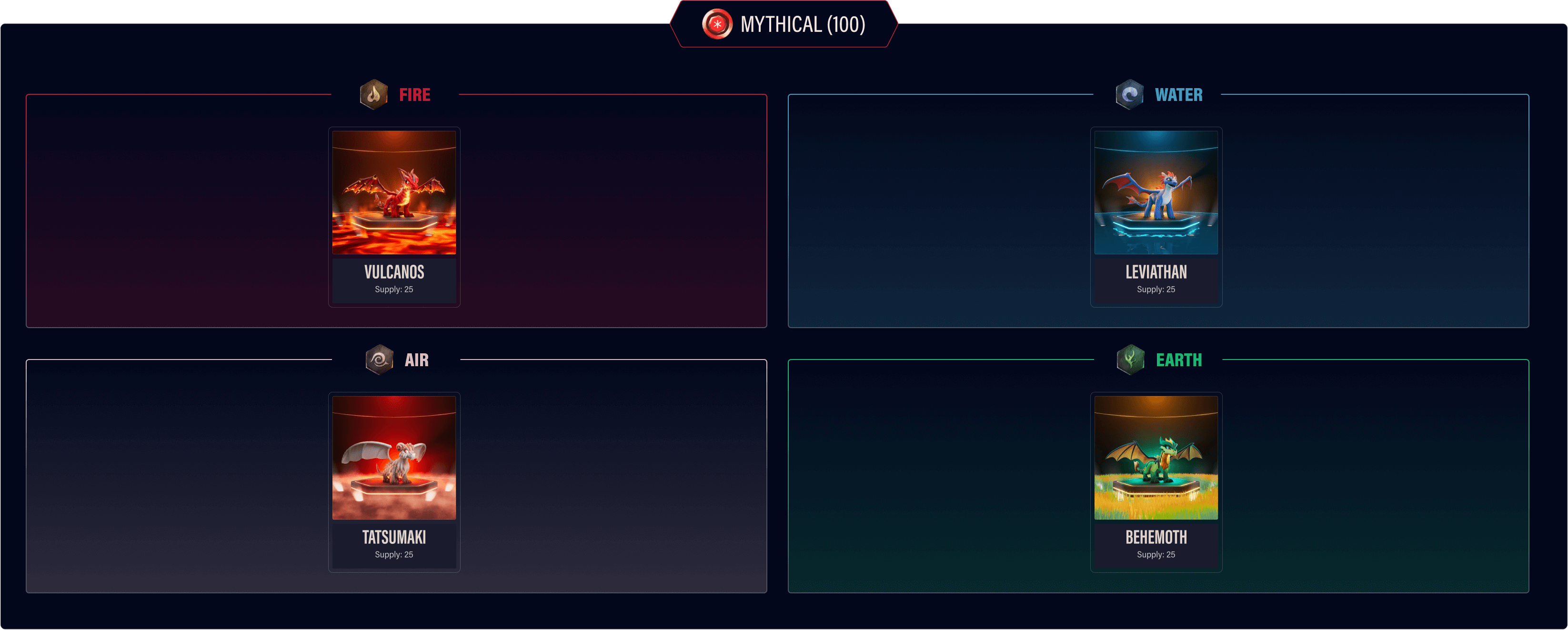 |
| Visuals made by @draysel |
All L1 Genesis NFT owners, including all Evolutions of Pixelmon Generation 1 Monsters, are anticipated to receive an L2 in-game NFT copy of their Pixelmon via airdrop. This is dependent, in part, on the full in-game functionality of the NFT.
Utility:
E1 Genesis NFT owners were eligible to receive a trainer NFT airdrop through staking, though this opportunity is now closed. All Genesis NFT owners retain the right to commercialize the use of the associated intellectual property and will receive a shared royalty for any commercial utilization thereof.
In the Pixelmon games, royalty calculations will be based on the total revenue generated by the IP, multiplied by a royalty percentage. This percentage escalates with the NFT's rarity tier and is also influenced by the frequency of the character's use by players within the game.
Serums NFTs & Creature Evolutions Genesis NFTs
Owners of Monsters Genesis NFTs can burn an Evolution Serum NFT to qualify for an airdrop of a higher evolution form. Each Monster can evolve twice from its E1 form. However, only selected species will have the option for a third evolution step (E4). The number of evolutions is limited, with higher evolutions being rarer: there will be only 2,800 E2 serums, 1,000 E3 serums, and 33 E4 serums in existence. These serums are awarded to Genesis NFT holders through raffles (such as Trainers Adventures and Party Quests) and as prizes in community events. Notably, to access the E3 and E4 serums, it's crucial to possess all available evolution steps of a specific species, known as "flushes."
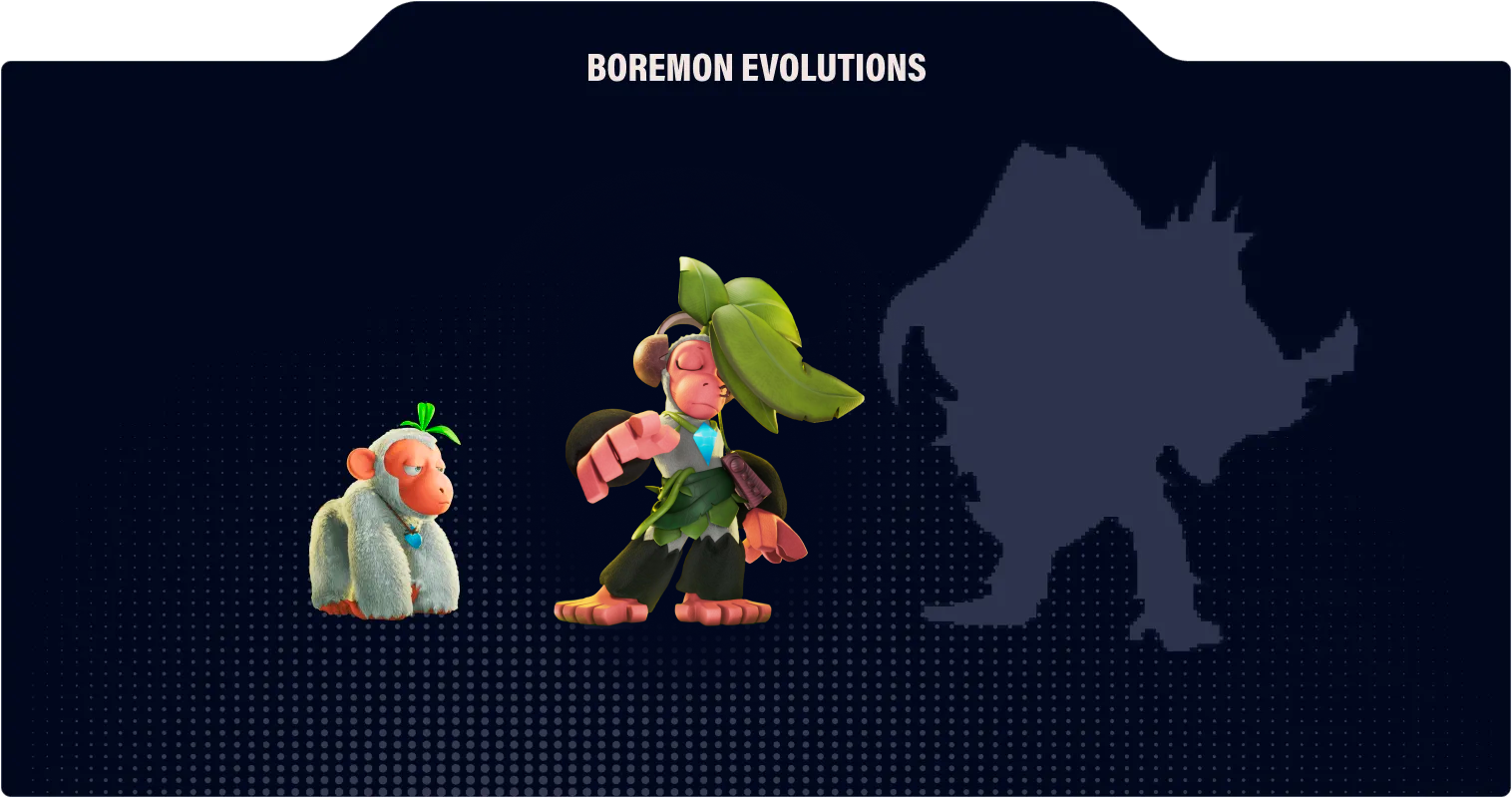
Utility:
All evolutions can claim IP royalties from a specific Monster Species: a fixed share of the total Species royalties will be allocated to each evolution. Therefore, if a Species has a limited number of E2 NFTs, individuals who burn a serum to evolve an NFT to the E2 stage for that Species stand to gain a larger benefit. See below for an example using Borg:
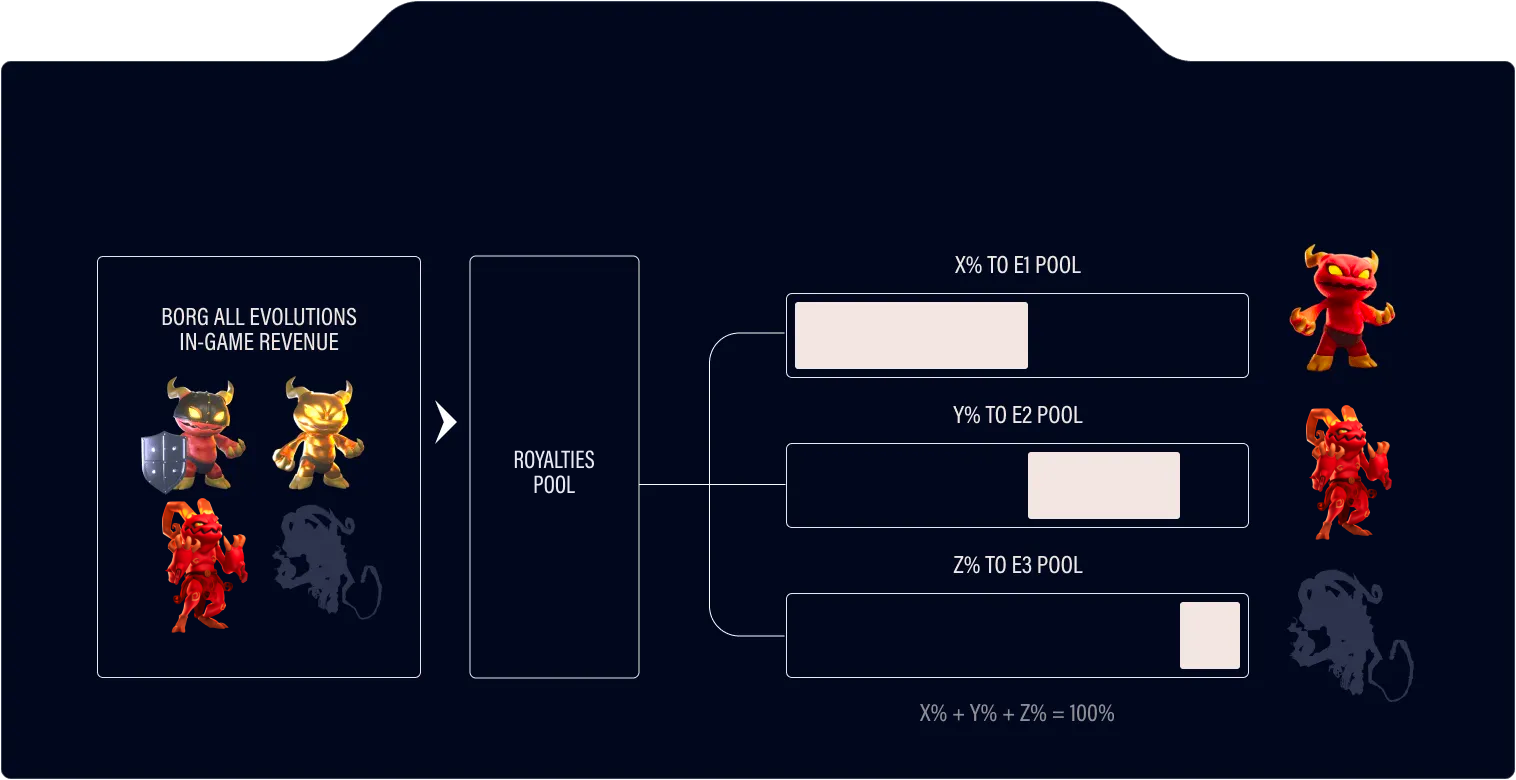
This mechanism encourages a more balanced use of serums across all Species. Increased serum usage on a single Species in-fact, results in the dilution of royalties paid to each individual NFT, thus incentivizing holders to consider evolving a wider range of Species.
Trainers Genesis NFTs & Gears NFTs
The Trainer NFT collection comprises 7,000 unique trainers, each generated from a mix of 176 different gears, armors, and accessories. This includes 20 unique full-body outfits and 40 unique weapons. Additionally, the collection features 20 Gold Trainers, which are uniquely customized NFTs distributed to the original holders of the Elite trainers.
The rarity of each Trainer is dictated by the rarity of the upper body clothing. Trainers were made available for claiming by holders of E1 Genesis Creature NFTs, with the condition that the rarity tier of the Trainer matches that of the Pixelmon. Due to a claim ratio of less than 100%, the Trainer collection is smaller in size compared to the Pixelmon E1 collection.
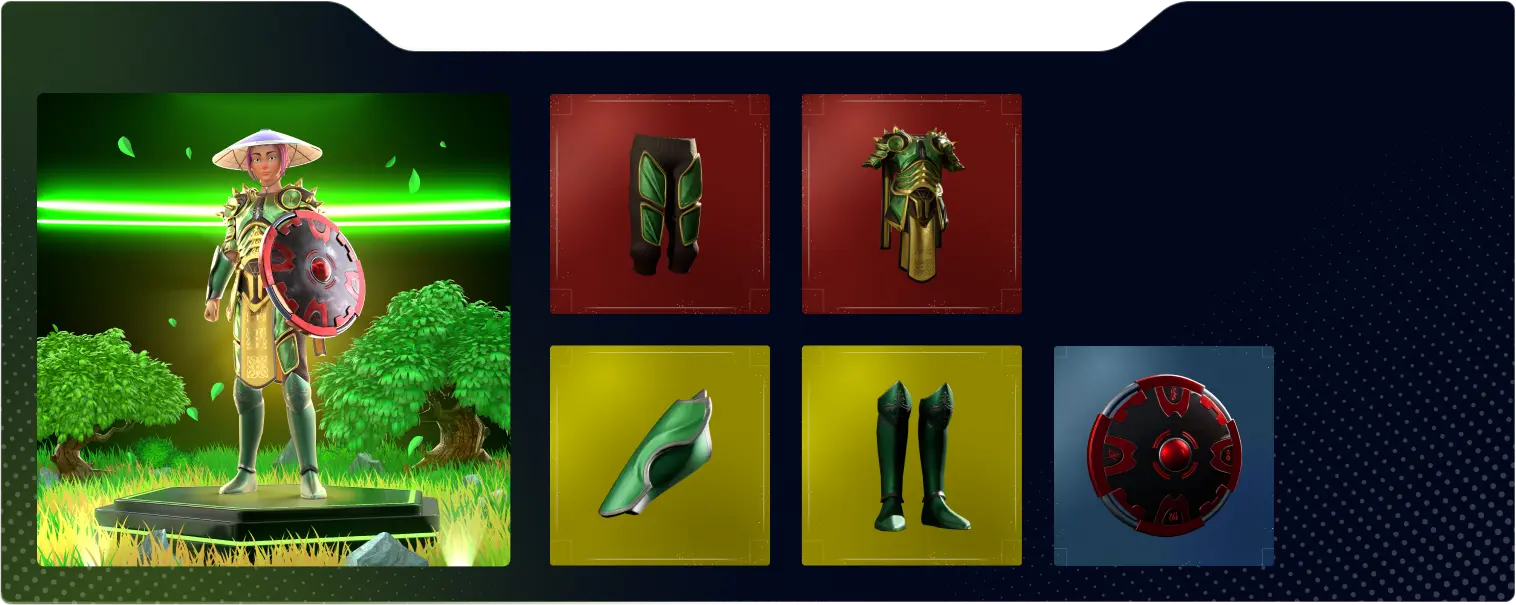
Utility:
Similar to the Pixelmon Genesis NFTs, each Trainer NFT grants shared IP rights for the unique combination of in-game gears each trainer possesses. Consequently, holders have a contractual right to source, negotiate, and commercialize the shared IP rights linked to that artwork, applicable both in-game and for any other commercial purposes.Trainer Genesis NFT holders are entitled to download the original 3D source files of their trainers, along with associated skins and gear, provided they have held the NFT for a minimum of 30 days.
Game Economy
Players can access the game's digital assets through various channels, including playing to own (P2O), buying from the game store, or trading on the secondary marketplace. This flexible structure caters to the preferred methods of access for different player types within the ecosystem. While all players will have access to P2O opportunities through gameplay, it's anticipated that Web2 players will lean towards purchases from the in-game shop, whereas Web3 players are likely to favor peer-to-peer exchanges.
|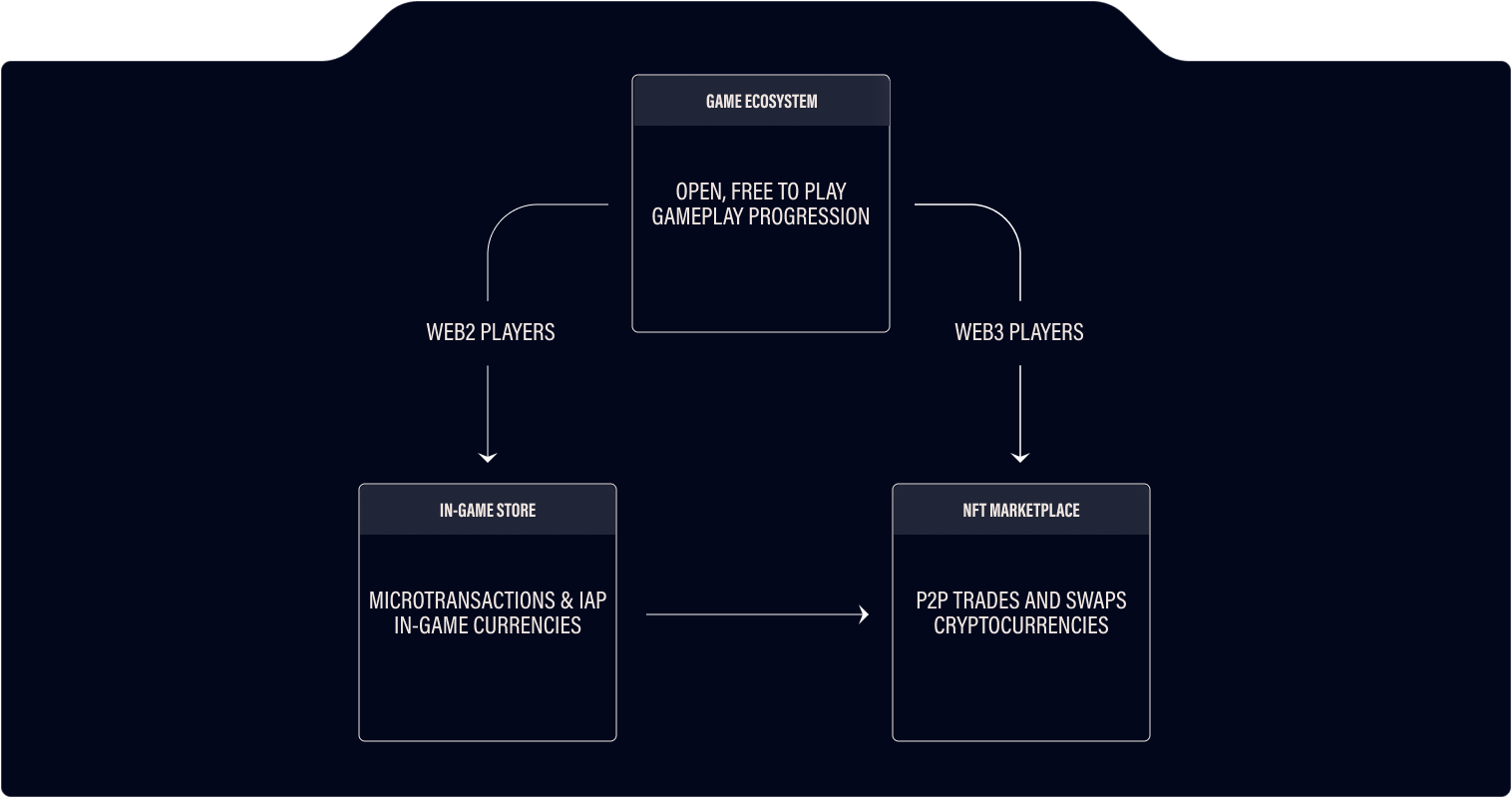 |
|
The Web2 economy of the games is constructed using traditional elements of Free-to-Play (F2P) game economic models. This includes a dual (off-chain) currency system consisting of a hard currency, which can be acquired through in-app purchases (IAP), and one or more soft currencies, each serving distinct functions within the games. Soft currencies can be earned through gameplay and player progression.
On the other hand, the Web3 economy will be driven by a dedicated web-based peer-to-peer (P2P) NFT exchange for in-game assets. This platform will enable Web3 players to trade their L2 NFTs with one another and exchange them for cryptocurrencies.
This strategy achieves multiple desirable outcomes:
- It guarantees a smooth gameplay experience for Web2 players, eliminates the barrier to entry for Web3, and maximizes the potential for user acquisition.
- It grants Web3 players complete ownership of in-game assets, facilitating unrestricted peer-to-peer trading and interoperability of these assets.
- The price discount on assets traded on the P2P platform, compared to those in the in-game store, serves as an incentive to transition Web2 gamers to Web3.
[#UGC]Creators Economy[#UGC]
We believe integrating a creator economy within the game can address the enduring challenge of content creation scalability in the gaming and consumer IP industry—that is, the demand for continuous new content in successful games and IPs.
In our vision, future expansions of game content and the associated IP, such as new generations of monsters, gear, armors, skins, and entire regions, will be created by both individual artists and professional studios.
 |
| Credits to @CapptainBB and @Dr_Clemento |
A comprehensive User Generated Content (UGC) system is essential for facilitating exponential and decentralized content creation across our suite of products and games. This approach will transform Pixelmon from merely a fun game into an IP ecosystem that is expanded and sustained by its user community.
Enabled by the Decentralized IP system, our User Generated Content (UGC) system allows artists to fund their work and distribute their IP, while also earning future royalties through the release of Genesis NFTs for their creations. This model ensures that artists are both funded and rewarded for their contributions. IP owners are motivated to secure new commercial opportunities, thereby strengthening the IP. Gamers gain access to an expanding array of quality content, contributing to ecosystem revenue and value through in-game microtransactions. This system offers sustainable benefits for Creators, Gamers, and Asset Owners alike.
Pixelmon NFTs and other digital assets are not intended to be used as investments and should not be considered as such. The value of NFTs and other digital assets can fluctuate greatly, and there is no guarantee of profit or return on investment. If you choose to purchase a Pixelmon NFT or other digital asset, you acknowledge that you are doing so for the sole purpose of owning and enjoying the digital asset, including its in-game use. We assume no responsibility for any financial loss that may result from the purchase or sale of a Pixelmon NFT or other digital asset. Do not purchase any Pixelmon NFTs or other digital assets with the expectation of profits, either from price appreciation, the potential receipt of future airdrops (which may never occur), or otherwise.
Certain statements that we make in this paper may constitute forward-looking statements, including information concerning potential licensing revenue, future airdrops and the expected roles and responsibilities of members of Tribes. These forward-looking statements are not guarantees, and they involve risks, uncertainties and assumptions and there can be no assurance that those potential future events will occur. We caution users not to rely on any forward-looking statements and expressly disclaim any obligation to update any forward-looking statement in the event it later turns out to be inaccurate.